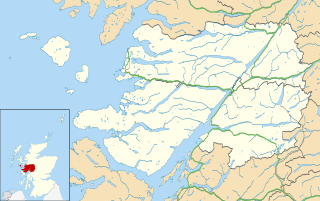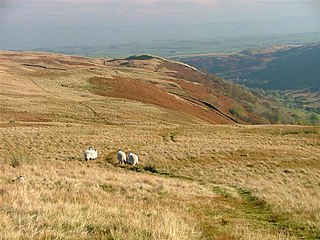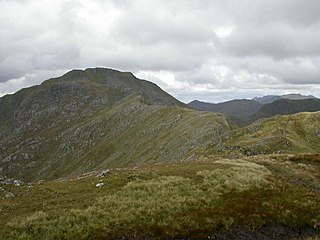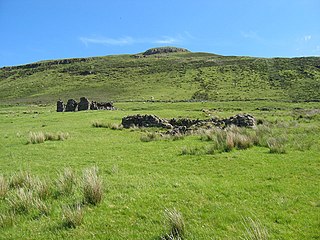
Kinloch Hourn is a small settlement at the end of Loch Hourn, in the West Highlands of Scotland. The name comes from the Gaelic, Ceann Loch Shubhairne, for "the head of Loch Hourn". Kinloch Hourn is at the end of 35 km (22 miles) of single-track road, which runs west from a junction with the A87 beside Loch Garry. [1]

Loch Hourn is a sea loch which separates the peninsulae of Kintail to the north and Knoydart to the south, on the west coast of Scotland.

The Highlands is a historic region of Scotland. Culturally, the Highlands and the Lowlands diverged from the later Middle Ages into the modern period, when Lowland Scots replaced Scottish Gaelic throughout most of the Lowlands. The term is also used for the area north and west of the Highland Boundary Fault, although the exact boundaries are not clearly defined, particularly to the east. The Great Glen divides the Grampian Mountains to the southeast from the Northwest Highlands. The Scottish Gaelic name of A' Ghàidhealtachd literally means "the place of the Gaels" and traditionally, from a Gaelic-speaking point of view, includes both the Western Isles and the Highlands.

Scotland is a country that is part of the United Kingdom. Sharing a border with England to the southeast, Scotland is otherwise surrounded by the Atlantic Ocean to the north and west, by the North Sea to the northeast and by the Irish Sea to the south. In addition to the mainland, situated on the northern third of the island of Great Britain, Scotland has over 790 islands, including the Northern Isles and the Hebrides.
From Kinloch Hourn, a path continues along the south side of the loch to Barrisdale. The path then climbs over Màm Barrisdale, before dropping down to the village of Inverie in Knoydart. This route once had a number of townships along it, and may have been used as a coffin road. [2] This is also used as a walking route into the mountains of Knoydart, including Ladhar Bheinn and Luinne Bheinn. [3]

Inverie is the main village on the peninsula of Knoydart in the Scottish Highlands and is concentrated on the north side of Loch Nevis. Although on the mainland of Britain, the few miles of single-track road are not connected to the rest of the national road network. Inverie is only reachable, aside from a 17-mile (27 km) hike over very rough terrain, by a regular 7-mile (11 km) ferry from Mallaig, giving the place a Guinness National Record for remoteness.

Knoydart is a peninsula in Lochaber, Highland, on the west coast of Scotland. Knoydart is sandwiched between Lochs Nevis and Hourn — often translated as "Loch Heaven" and "Loch Hell" respectively, although the somewhat poetic nature of these derivations are disputed. Forming the northern part of what is traditionally known as na Garbh-Chrìochan or "the Rough Bounds", because of its harsh terrain and remoteness, Knoydart is also referred to as "Britain's last wilderness". It is only accessible by boat, or by a 16-mile (26 km) walk through rough country, and the seven miles (11 km) of tarred road are not connected to the UK road system.

Corpse roads provided a practical means for transporting corpses, often from remote communities, to cemeteries that had burial rights, such as parish churches and chapels of ease. In Britain, such routes can also be known by a number of other names, e.g.: bier road, burial road, coffin line, coffin road, corpse way, funeral road, lych way, lyke way, or procession way. etc. Such "church-ways" have developed a great deal of associated folklore regarding ghosts, spirits, wraiths, etc.
To the north of Loch Hourn is the route of an old drove road, which ran between Kinloch Hourn to Glenelg. Cattle from Skye were driven across Kyle Rhea to Glenelg, along this route to Kinloch Hourn, then onwards down Glen Garry. [4]

Glenelg is a scattered community area and civil parish in the Lochalsh area of Highland in western Scotland. Despite the local government reorganisation the area is considered by many still to be in Inverness-shire, the boundary with Ross-shire being at the top of Mam Ratagan the single track road entry into Glenelg.













